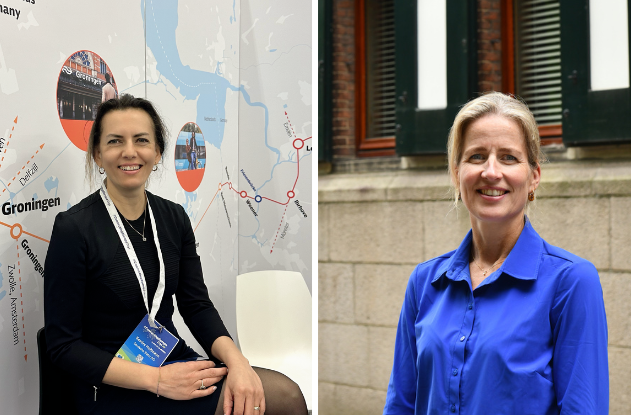In the picture: Sandra (left) and Jiska (right)
The same, yet different
Project managers Jiska and Sandra share the same job title, but whether they speak to each other regularly? Actually, no. Why is that? "Deutsche Bahn has a different structure in the organization," Sandra explains. "I work with eight other team members, each with their own area of expertise. One person supervises superstructure, another supervises signals, another supervises bridge construction, another supervises environmental issues, and so on. I am above them and support where I can."
Jiska's position, on the other hand, is more wide-ranging. As project manager, she works with her team members, agencies and contractors on various rail projects: "I also work for other projects of ProRail, for example Groningen Suikerzijde station and the reactivation of Veendam - Stadskanaal."
Technical differences
The Dutch and German railroads are quite different in technical terms. Think of the rails, the metal rails on which trains ride and the attachment to the sleepers, the beams that support the rails. Sandra: "In the Netherlands, for example, the cables are buried in the ground, while in Germany they build concrete cable ducts in which the cables are laid above the ground.
"It is very important that the Dutch and German contractors consult well with each other on this. A different mother tongue doesn't always make that easy." - Jiska Kazius-van der Meulen
Also, the train protection system (the operation of the signals) is different. The technical challenge is to make a transition that can operate both systems and not forget anything in the process. "The train safety system is the biggest challenge as far as I'm concerned," Jiska adds. "It is very important that the Dutch and German contractors consult well with each other on this. A different mother tongue doesn't always make that easy. The working language is a combination of English and German and we do have to understand each other completely. That's why we double-check everything."
All partners round the table
But the different languages are certainly not the only challenge in the project. Sandra: "For me, the challenge is mainly in getting all the partners around the table. We are working with 10, 11 contractors on one construction site. And then we all have to be on the same page. We really have to work together to solve problems."
Jiska: "With us, it's easier. We work with one contractor. This does involve several subcontractors. My challenge lies in the various factors we have to take into account. For example, we have to deal with local residents, there is a large budget to monitor and the pool frog is present at one location. This is a protected species for which we have to take special measures."
Large playing field
In railroad cooperation between two countries, you sometimes encounter cultural differences. Jiska: "I think the Dutch are more open about the challenges we encounter during the project. It is more normal in the Netherlands to talk about problems without having to immediately put a solution on the table. With our German colleagues, I do sense when there are problems, but I don't actually hear about them until the solution is already known."
Sandra: "We also have many more steps within a decision-making process, which can sometimes be intensive. Often there are standard process steps to go through before a decision can be made." According to Jiska, this is indeed less strict in the Netherlands. "I feel I have a big playing field where I can make my own choices with my project team."
My biggest milestone so far is that we have finally started building, we can't go back now but are moving forward." - Sandra Hoffmann
Milestones ahead
Sandra: "My biggest milestone so far is that we have finally started building, we can't go back now but are moving forward. We started in Germany as early as 2023 on the Ihrhove-Friesenbrücke section. The entire section should be completed by 2025."
Jiska: "When the work is finished on the Dutch side, I will definitely be on that first train from Groningen to Leer!" Sandra, too, is going to try out that connection. "And I'm looking forward to the Friesenbrücke being open soon. That one has been broken since 2015 due to a collision with a freighter." Jiska: "Yes, to see that one open will be very special."
Beer and bratwurst
How will it be celebrated when the first train soon runs over the entire route, including the Friesenbrücke? "With beer and bratwurst," Sandra laughs. Jiska: "It will probably be combined with a party with all the stakeholders, and there really are a lot of them with this project. It would be fun to have a cake and a beer with everyone!"
